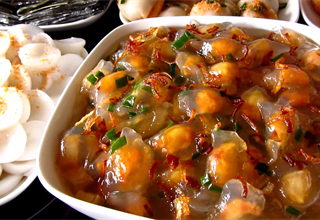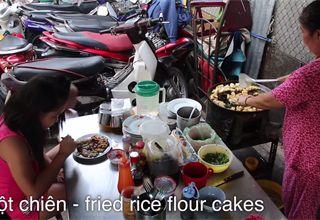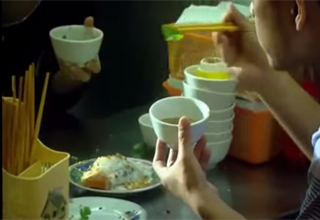Banh khuc is a traditional cake that originated in the Red River Delta hundreds of years ago and in Bac Ninh province it is considered more than just a snack – there it symbolises faithfulness and nobility.
It was originally made as a special dish to offer guests at religious rituals or festivals of Quan Ho (traditional love duets) along with betel and areca. Made from glutinous rice and filled with green bean, pork, herbs and spices, banh khuc looks rather like onigiri, the Japanese rice-ball.
Cudweed is also a crucial ingredient for banh khuc. There are two kinds of cudweed – one is called nep and the other te. The former is more flexible and fragrant and usually preferred for making banh khuc. The quality and fragrance of cudweed varies from place to place as it depends on the quality of the soil. Cudweed leaves are picked at dawn when still wet with dew.
The leaves are washed, ground then mixed with husked glutinous rice, which is ground into a paste. Green beans, pork, dried onion and pepper are mixed together and rolled into balls, which are covered by a thin layer of cudweed and rice paste. Finally, the cakes are sprinkled with grains of glutinous rice known as “clothes”.
The balls are then steamed and should be served hot and dipped in a mixture of roasted and crushed sesame seeds and salt. “Banh khuc is truly delicious. I will never forget the taste until the day I die!” says Pham Thi Thoa, a pensioner from
But as time goes by it is increasingly difficult to find cudweed as fields are eaten up by urbanisation and the plant has apparently been adversely affected by certain kinds of fertilisers used in the countryside. Although you can still find banh khuc in
The most famous banh khuc are arguably made by 50-year-old Nguyen Thi Lan, who sells her produce on Nguyen Cong Tru, Son Tay and Yen Phu streets. According to Lan each shop sources cudweed in provinces neighbouring
The best cudweed in
“We have our own ways of making banh khuc. But basically you need to use quality cudweed and can’t mix it with morning glory, cabbage or kohlrabi,” says one vendor, Nguyen Thi Van from Ngoai Hoang. “You will see, my cake is very fresh, fragrant and tasty!” “I usually earn VND150,000 a day but I have to work round the clock,” she adds.
“Some people are like addicts and have to eat banh khuc every day. I even have some customers who will pay me in advance!”
Source: VietNamNet//Timeout

















COMMENTS